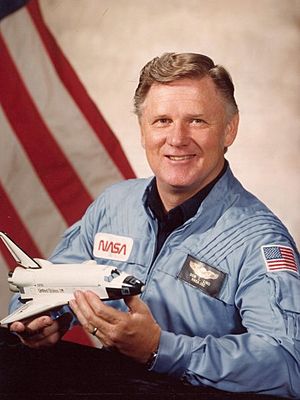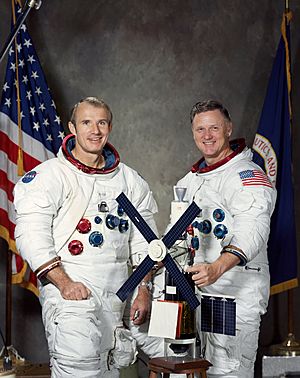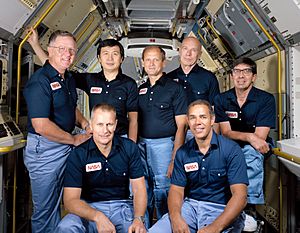Don Lind facts for kids
Quick facts for kids
Don Lind
|
|
|---|---|
 |
|
| Born |
Don Leslie Lind
May 18, 1930 Midvale, Utah, U.S.
|
| Died | August 30, 2022 (aged 92) Logan, Utah, U.S.
|
| Alma mater |
|
| Occupation | Naval aviator, scientist |
| Space career | |
| NASA Astronaut | |
| Rank | |
|
Time in space
|
7d 00h 08m |
| Selection | 1966 NASA Group 5 |
| Missions | STS-51-B |
|
Mission insignia
|
|
| Retirement | April 1986 |
| Scientific career | |
| Fields | Physics |
| Thesis | Differential distribution of charge-exchange and inelastic neutrons in Π−-p interactions at 313 and 371 MeV. (1964) |
Don Leslie Lind (May 18, 1930 – August 30, 2022) was an American scientist, naval officer, aviator, and NASA astronaut. He was born in Midvale, Utah.
Don Lind earned a bachelor's degree in physics from the University of Utah in 1953. Later, he received a PhD in high-energy nuclear physics from the University of California, Berkeley in 1964. He also served as a Naval Aviator and reached the rank of Commander in the United States Navy Reserve.
Lind joined NASA as an astronaut in 1966. He helped plan activities for the Apollo 11 mission. He also worked as a communicator (CAPCOM) for the Apollo 11 and Apollo 12 missions. He was a backup pilot for the Skylab 3 and Skylab 4 space stations.
His only space flight was on STS-51-B in 1985. He was the Payload Commander for this mission. He even designed an experiment to photograph the Earth's aurora. The Orbiter Challenger completed 110 orbits. It landed safely after seven days in space.
Contents
Life Story
Early Life and School
Don Lind was born on May 18, 1930. He grew up in Midvale, Utah, with his two sisters. He went to Midvale Elementary School. Then he graduated from Jordan High School in 1948.
He was an Eagle Scout with the Boy Scouts of America. This is the highest rank in scouting. In 1953, he earned a Bachelor of Science degree in physics from the University of Utah. He graduated with high honors.
While flying for the Navy, Lind helped the University of California, Berkeley. He took high-altitude photos of cosmic rays. This helped him get into Berkeley. There, he studied high-energy nuclear physics. He earned his PhD in 1964. Later, he did more research at the University of Alaska Fairbanks from 1975 to 1976.
After college, Lind joined the United States Navy. He went to Officer Candidate School in Rhode Island. He jokingly asked for flight training. But he found he really enjoyed flying. He became a Naval Aviator in 1955.
He served four years on active duty with the Navy. He flew from San Diego and from the aircraft carrier USS Hancock. Throughout his Navy and NASA careers, Lind flew over 4,500 hours. About 4,000 of those hours were in jet aircraft. He continued to serve in the United States Navy Reserve until 1969. He left the Navy as a Commander.
NASA Career
Becoming an Astronaut

From 1964 to 1966, Lind worked as a space physicist at the NASA Goddard Space Flight Center. He studied tiny particles in Earth's magnetosphere and in space.
Lind wanted to be an astronaut. He applied for NASA's third group of astronauts. He was too old for the fourth group by just 74 days. But NASA changed the age rule. So, he was chosen in April 1966 with the fifth group of astronauts. This group was called the "Original Nineteen."
Apollo Missions
Lind worked with geologist-astronaut Harrison Schmitt. They helped plan the spacewalks for Apollo 11. They also helped develop tools used on the lunar surface. Lind also worked as a capsule communicator (CAPCOM). He talked to the astronauts during the Apollo 11 and Apollo 12 missions.
Skylab Missions
Lind was assigned to the Skylab program in 1969. He was a backup pilot for Skylab 3 and Skylab 4. These were the second and third manned Skylab missions. He was also ready for a rescue mission. This mission would have been needed if the Skylab 3 crew had problems.
Astronauts often didn't know why they were chosen for certain missions. Lind was a scientist-pilot. He worked hard on the Earth resources package for Skylab. But he was not chosen for the main Skylab 4 crew. He chose to stay as a backup pilot. This was because the rescue mission would only need a commander and a pilot.
Lind felt sad when the unused Skylab B was sent to a museum. He said he was "in the right place at the wrong time." He was later assigned to the Science and Applications team in 1974. This made his role as a scientist-astronaut official.
Space Shuttle Flight
For the Space Shuttle program, Lind became a Mission Specialist. He helped develop equipment for early Space Shuttle missions.
Lind finally flew into space on STS-51-B. This mission was from April 29 to May 6, 1985. He was the lead Mission Specialist and Payload Commander. He spent over 168 hours in space. Lind waited 19 years for his spaceflight. This was the longest wait for any continuously serving American astronaut. The crew of STS-51-B was also the oldest for an American space mission, with an average age of 48.6.
STS-51-B was the first full Spacelab science mission. It launched from Kennedy Space Center, Florida. The seven-person crew studied many things. They looked at crystal growth, how liquids behave in space, and gases in the atmosphere. They also studied cosmic rays, laboratory animals, and human health in space.
Lind worked with a group from Alaska. He designed an experiment to photograph the Earth's aurora. This experiment was very cheap. It only needed three rolls of film for $36. Lind called it "the cheapest experiment that has ever gone into space." After orbiting Earth 110 times, the Orbiter Challenger landed at Edwards Air Force Base, California, on May 6, 1985.
Lind retired from NASA in 1986. This was 20 years after he was chosen as an astronaut. For nine years, he taught physics and astronomy at Utah State University. He retired from teaching in 1995.
Awards and Honors
Lind was a member of several important science groups. These included the American Geophysical Union and the American Association for the Advancement of Science. He was also an Eagle Scout.
He received the NASA Exceptional Service Medal in 1974. After his flight on the Challenger, he was given the NASA Space Flight Medal.
Personal Life
Don Lind married Kathleen Maughan. They had seven children together. His son, David, was worried about appearing on TV like other astronaut families. But Kathleen said that their family was better off without too much publicity.
Lind was an active member of The Church of Jesus Christ of Latter-day Saints. He served as a missionary before college. After his space flight, he spoke about his experience at a church conference. He and Kathleen also served as missionaries in Europe and at temples.
Kathleen, his wife, passed away on June 12, 2022. Don Lind died on August 30, 2022, in Logan, Utah. Many of his children and grandchildren were with him. His funeral was held in Smithfield.
See also


